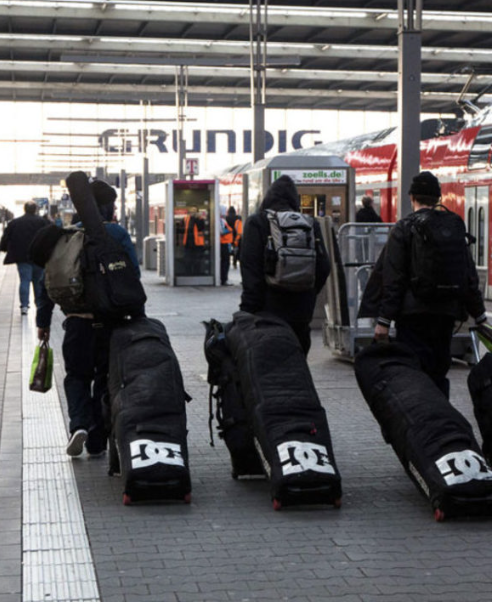How to Fly with Skis & Snowboards
Your ski trip is locked in, and now comes the packing. While traveling with ski and snowboard gear may seem daunting, it’s easier than you think—with the right bag and a little prep. From protecting your equipment to navigating airport logistics, this guide will ensure a smooth travel experience for you and your gear.
Choosing the Best Ski & Snowboard Baggage
Traveling with bulky gear like skis and snowboards can be tricky, but investing in the right travel bag makes all the difference. We recommend soft-sided, wheeled, padded bags for easy and safe transportation. These bags simplify airport navigation, snow-covered streets, and hotel lobbies while providing enough room for skis, snowboards, poles, helmets, goggles, and clothing!
Best Options by Type:
For Skiers: A double ski roller bag offers the best functionality. These bags are spacious, durable, and designed for long journeys.
For Snowboarders: A roller snowboard bag is a fantastic choice, offering extra room for gear while ensuring safe transport.

Soft-Sided vs. Hard Cases:
Soft-Sided Bags: These are lightweight, easier to maneuver, and often padded to protect your gear. They’re ideal for general travel and provide additional space for clothing and accessories.
Hard Cases: Perfect for protecting precious cargo, hard cases offer unmatched durability and security. However, they can be bulky, heavier, and harder to fit into tight spaces like car trunks.
Pro Tip: Nonwheeled, soft-sided bags are more cost-effective and practical for short trips (like from your car to a condo). But for long-distance travel or air travel, a wheeled bag is a game-changer.

https://offpistemag.com - Dakine Boundary Double Roller Ski Bag
The Gold Standard in Ski & Snowboard Luggage
The Backcountry Double Ski & Snowboard Rolling Bag is one of the best options. This bag lets you pack multiple pairs of skis or snowboards—perfect for those who like to bring options, such as carving skis for groomers and powder boards for deep snow.
Traveling with just one set of skis or a single snowboard? Use the extra space for boots, helmets, and clothing.
If you’re traveling with a friend, one shared bag might be all you need to carry two sets of gear.

Key Considerations for Choosing Your Bag
Non-Padded Bags: Best for keeping snow and dirt off your gear during short commutes. If you go with this option, protect your gear with soft items like scarves, gloves, or clothing.
The Boot Bag
Many airlines allow you to check a ski or snowboard bag and a boot bag as one item. However, we recommend carrying your boots in your carry-on luggage. Why? Boots are more challenging to rent than skis or snowboards, especially if custom-molded to your feet.
Use a dedicated boot bag with compartments for goggles, gloves, and other essentials, like the Backcountry Ski Boot Bag.
For added convenience, attach your boot bag to your carry-on backpack or stash a day’s worth of essentials inside.

Packing Tips for Ski & Snowboard Travel Bags
Option 1: Everything in the Board Bag & Backpack
Pack all your clothes, gear, and accessories in one snowboard or ski bag.
Roll your clothes tightly like burritos to maximize space and prevent wrinkles.
Use small stuff sacks to organize items like socks, gloves, and underwear.
Organize the bag vertically, with gear on one side and clothing on the other.
Option 2: Separate Suitcase for Clothes
If you have a lot of gear, consider bringing a separate suitcase for your street clothes.
While this adds bulk, it keeps your ski or snowboard bag light and organized.
Option 3: Ship Your Gear Ahead
For ultimate convenience, ship your gear directly to your destination. While pricier, it eliminates the hassle of lugging heavy bags through airports.
Remember a Backpack!
A backpack is an essential companion for air travel. Look for one with:
A helmet-carrying system to protect your helmet during transit.
Dedicated compartments for smaller items like snacks, electronics, and travel documents.

Airline Ski & Snowboard Baggage Policies
Each airline has its own policies for checking ski and snowboard equipment. Here are some general rules:
Most airlines treat ski and snowboard bags as regular luggage.
A ski or snowboard bag and a boot bag are often counted as one piece of luggage, provided their combined weight is under 50 lbs.
Important: Always double-check your airline’s policies before flying, as baggage rules can vary or change. Investing in a luggage scale is a smart way to avoid surprises at the airport.
With the right bag, packing strategy, and preparation, flying with skis or snowboards can be a breeze. So, gear up, hit the slopes, and enjoy your adventure!
